Table of Contents

Salmon vitamins are very abundant, it is the reason why some people refer to this fish as a “superfood”.
Not only does salmon offer a wide variety of vitamins, but it also offers omega 3 fatty acids and astaxanthin which gives salmon the orange color.
In a previous article, we went into debt about why you should never consume undercooked salmon you can check it here!
But in this article, we will learn about the different vitamins that salmon offers, how to buy the best salmon from your local market, as well as how to consume salmon the best way to get the most of its nutrients.
Salmon vitamins:
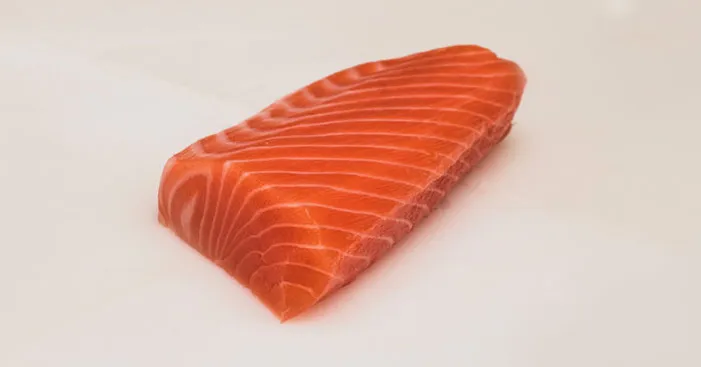
Being a fatty fish alongside Sardines, Bluefin tuna and Mackerel, salmon is composed with 10% of fats. (1)
This may sound unhealthy, but most of those fats are omega 3 fatty acids which are essential for many body functions.
However, we are focusing with the types of vitamin in salmon to figure out the possible health benefits we can get from this fish.
Salmon vitamins: vitamin D
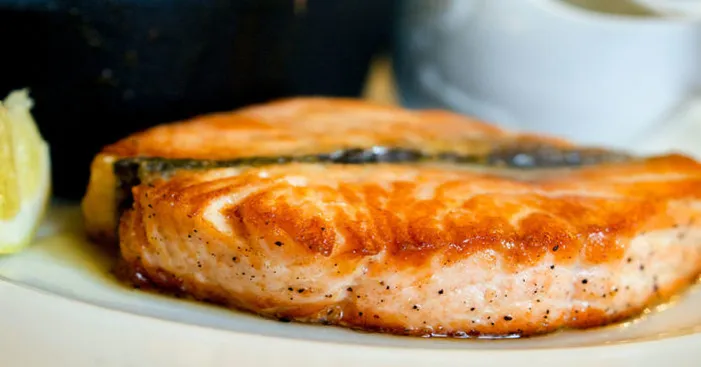
Rarely present in dietary products, we mostly get our D vitamin from the sun.
To be more specific, we don’t get vitamin D from the sun, but we have receptor cells on our skin that can produce vitamin D2 and D3 when exposed to sunlight. (2)
When it comes to salmon, it offers a good amount of vitamin D3 with more than the daily need per serving.
This vitamin found in salmon is often known as “bone vitamin” as it plays a key role in absorbing calcium.
As the most abundant mineral in the body, calcium is very hard to be absorbed as the body needs the help of vitamin D.
Especially during winter and cloudy weather or even when we just don’t have time to go out, we find ourselves with a shortage of sunlight.
When this occurs frequently, our bodies start experiencing vitamin D deficiency and need to get this vitamin from food supplements.
By eating salmon once a week, we would ensure that our bodies always have a backup plan to get their need in vitamin D. (3)
A body that gets enough vitamin D has a lower risk of developing cancer or neurological deterioration related to aging. (4)
In addition, this vitamin also protects against osteoporosis as it maintains bone density by retaining and absorbing calcium.
Just a half salmon fillet would offer more than the daily need in vitamin D.
Salmon vitamins: vitamin A
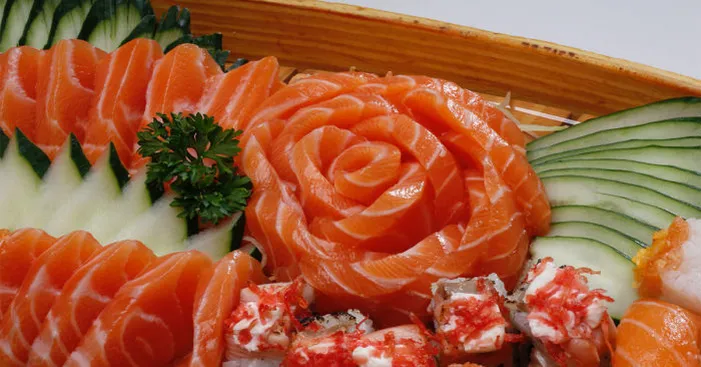
With fewer quantities compared to other vitamins in salmon, this fish offers about 10% of the daily need in vitamin A (Retinol or beta-carotene).
This vitamin contributes to the metabolism of Iron and helps to maintain good sight and good skin health. (5)
On the skin level, vitamin A is responsible for skin pigmentation which means it gives the skin the property of getting a tan naturally.
As for the sight level, it is vitamin A the nutrient that gives our eyes a better adaptation in the dark.
Vitamin A is also a very strong antioxidant the reason why many people refer to it as “the anti-aging vitamin”.
Thanks to these antioxidant properties, eating salmon regularly guarantees good protection against free roots the main source of many diseases.
Salmon vitamins: vitamin E
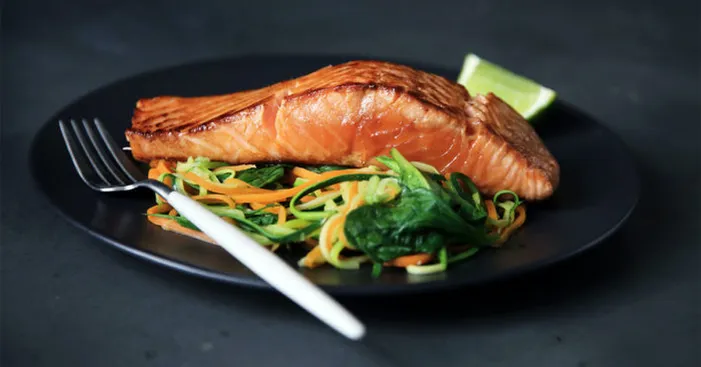
You also get more than 50% of the daily need in vitamin E in just one serving of 3 ounces (85g) of salmon fillet.
This vitamin has very strong antioxidant properties and is able to protect the body from oxidative stress the source of many diseases.
By consuming salmon regularly, we get enough vitamin E to protect the body from damages on the cell level.
For instance, in a diet with enough vitamin E, the body has enough resistance against aging.
Many types of research have been done on the effect of vitamin E in salmon and it shows great ability to prevent the oxidation of unsaturated fatty acids. (6)
Also, this nutrient widens arteries and veins which significantly improves the blood flow and that protects against cardiovascular diseases.
Other studies also show great promising results with vitamin E from salmon being a possible preventive treatment against cancer. (7)
Salmon vitamins: B vitamins
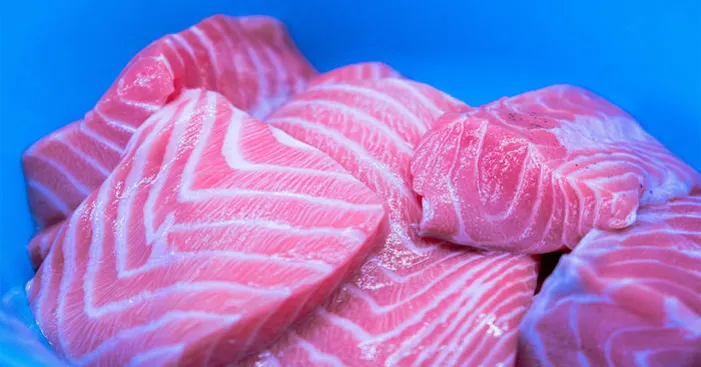
Salmon is a great source of many vitamins from the B group including B1, B2, B3, B5, B6, B9, and B12.
These vitamins offer a great protective effect against many diseases such as cancer and age-related diseases.
Vitamins exist in two different forms either fat-soluble or water-soluble and B vitamins are water-soluble. (8)
Vitamin B1:
Once this vitamin gets in our system it gets transformed into its active form TPP (thiamine pyrophosphate) by the liver.
Once it gets processed it plays a key role in the production of several enzymes which convert sugar into energy. (9)
In addition, thiamine (B1) ensures proper transmission of the nerves, and that results in the well-being of the memory and cognitive reasoning.
Vitamin B2:
Among the other vitamins, salmon also offers about 35% of the daily need in vitamin B2 per serving (3ounces , 85g).
Scientifically, this nutrient also goes by the name “riboflavin” and it acts on many body functions.
In fact, vitamin B2 maintains the well-being of red blood cells and also plays a role in converting food to energy. (10)
Particularly, it is among the essential components that play a major role in the oxidation of glucose to produce energy.
You should also know that a diet low in vitamin B2 leads to a skin disorder, hair loss, and problems with the reproductive system…
Vitamin B3:
As one of the most abundant vitamins in salmon, vitamin B3 or Niacin is a very essential nutrient for the proper functioning of the body.
One serving of salmon fillet (3oz or 85g) offers more than 100% of the daily need in Niacin.
One good thing about vitamin B3 is that it resists high temperature when cooked therefore there is a minimum amount lost during the process. (11)
Our bodies use vitamin B3 to maintain the well-being of our skin and the nerve system.
For instance, Niacin acts on the cellular level by maintaining the elasticity of the arteries to support good blood circulation. (12)
Also, consuming salmon once a week will supply the body with its need for vitamin B3 which can reduce the level of bad cholesterol.
Vitamin B6:
Not only do salmon offer 100% of the daily need in Niacin per serving, but it also offers 100% of the daily need in vitamin B6 as well.
This vitamin goes by the scientific name “Pyridoxine” and it plays many essential roles.
Among those roles, it is involved in the production of hemoglobin (red blood cells) and also regulates hormonal activity. (13)
Eating salmon would supply the body with vitamin B6 which ensures the good functioning of the immune system.
Several studies show the effectiveness of vitamin B6 to reduce fatigue and boost energy levels. (14)
As for hormonal production, this vitamin in salmon also plays a role in the production of serotonin and melatonin.
The two hormones are responsible to give us a feeling of joy and happiness as well as maintaining good sleep.
Vitamin B12:
This is also another vitamin that is very abundant in salmon as one serving of this fish contains more than 100% of vitamin B12.
You may find some articles and studies that refer to this vitamin as “Cobalamin” and it is involved in cells division.
Being a vitamin of the B group, B12 also plays a part in the conversion of food into energy as well as ensuring the proper functioning of the immune system.
In addition, vitamin B12 breaks down “homocysteine” which is an amino acid that the body produces by using protein from the food we eat.
Studies prove that high homocysteine levels are linked with vitamin deficiency and could lead to blood clotting, dementia, and cardiovascular diseases. (15)
How to benefit from vitamins in salmon?
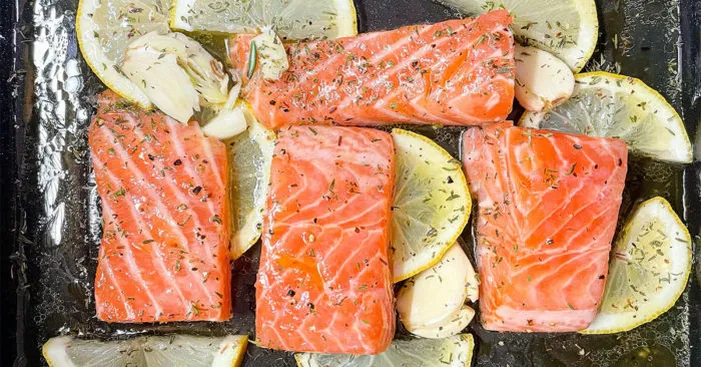
Since we don’t eat salmon raw, we should pay close attention to the way we cook it so that we don’t lose most of the nutrients during the process.
Salmon offers vitamin A, D, E, B vitamins, omega 3, astaxanthin, and many other essential nutrients.
There are fat-soluble nutrients like astaxanthin, vitamin D, and vitamin E that are better absorbed when we consume them with oil. (16)
Therefore, the best way to consume salmon fillet is sautéed with olive oil or butter.
Also, lemon enhances the taste of most seafood products therefore a steamed salmon with lemon could be a great way to consume this fish.
Some people like to get rid of salmon skin and that is a waste of nutrients as the skin contains a good amount of omega 3 and collagen. (17)
Because of that, try to also use the skin of salmon when you make your fish recipe so that you get the most possible nutritional virtues.
Buying salmon:
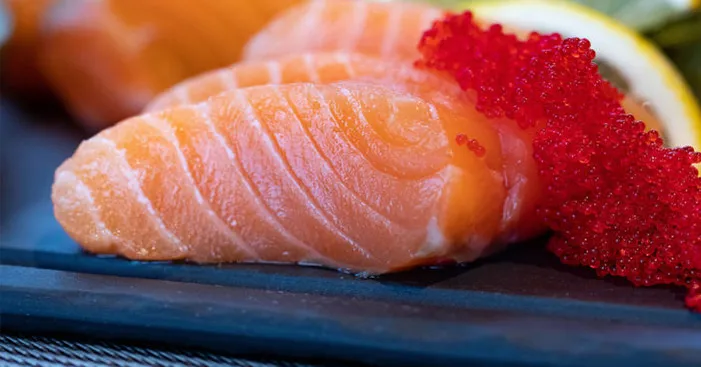
In the market, the majority of salmons are farmed however you can still sometimes find wild fish.
Like any other type of seafood, wild salmons tend to be slightly rich in nutrients compared to farmed ones.
However, wild salmons are a bit expensive but surely have a firmer texture and much tastier meat.
We should also know that wild salmon are probably more exposed to toxins and can store chemicals in their fatty tissues. (18)
This doesn’t mean that farmed salmon are free of toxins as some of them are farmed in polluted environments.
This should not be a concern in the US, as we will mostly only find safely farmed salmon (FDA certified) in the market and those are free of toxins.
Even though farmed salmons are fattier and have less flavorful meat, they are less expensive and more available.
The smell of salmon must not have an ammonia aroma as that is a sign of spoilage.
Fresh salmon fillets are richer in vitamins and nutrients and tend to have a bright orange color.
References:
(1): Fatty Fish & Your Cholesterol (webmd.com)
(2): Vitamin D Myths ‘D’-bunked > News > Yale Medicine
(3): Wild Salmon Affirmed as Top Vitamin D Source (vitalchoice.com)
(4): Vitamin D and Ageing: Neurological Issues (karger.com)
(5): Vitamin A: foods, functions, how much do you need & more | Eufic
(6): The Role of Vitamin E in Human Health and Some Diseases (nih.gov)
(7): Vitamin E and cancer prevention – PubMed (nih.gov)
(8): The Difference Between Fat-Soluble and Water-Soluble Vitamins – Ritual
(9): Vitamins to Help Break Down Carbs (sfgate.com)
(10): Sight and Life Introduces Vitamin B2: A Key to Converting Food into Energy
(11): Vitamin B3 – Alvityl
(12): Niacin – Consumer (nih.gov)
(13): Vitamin B6 | The Nutrition Source | Harvard T.H. Chan School of Public Health
(14): Vitamin B status in patients with chronic fatigue syndrome – PubMed (nih.gov)
(15): Homocysteine: Levels, Tests, High Homocysteine Levels (clevelandclinic.org)
(16): Valensa Introduces New ‘Body Ready’ Astaxanthin Formulation for Optimal Absorption (prnewswire.com)
(17): The Benefits of Salmon Skin (thechoppingblock.com)
(18): Fish Faceoff: Wild Salmon vs. Farmed Salmon – Cleveland Clinic
